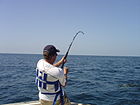Amadou: Difference between revisions
add another citation for use in hat-making |
Cyberbot II (talk | contribs) Rescuing 1 sources. #IABot |
||
| Line 16: | Line 16: | ||
{{wiktionary|amadou}} |
{{wiktionary|amadou}} |
||
* http://www.rogersmushrooms.com/gallery/DisplayBlock~bid~5928~gid~.asp |
* http://www.rogersmushrooms.com/gallery/DisplayBlock~bid~5928~gid~.asp |
||
* http://www.bushcraftuk.com/content/articles.php?action=show&showarticle=175 |
* http://web.archive.org/web/20070203071356/http://www.bushcraftuk.com:80/content/articles.php?action=show&showarticle=175 |
||
* http://www.bushcraftuk.com/forum/content.php?r=307-Polypore-Fungi-in-Primitive-Fire-Making |
* http://www.bushcraftuk.com/forum/content.php?r=307-Polypore-Fungi-in-Primitive-Fire-Making |
||
* http://www.primitiveways.com/Amadou%20substitutes.html |
* http://www.primitiveways.com/Amadou%20substitutes.html |
||
Revision as of 01:26, 21 March 2016


Amadou is a spongy, flammable substance prepared from bracket fungi. The species generally used is Fomes fomentarius (formerly Ungulina fomentaria or Polyporus fomentarius), which in English is also called "horse's hoof fungus" or "tinder fungus". The amadou layer can be found on top of the fungus just below the outer skin and above the pores.[1] It is traditionally used as tinder, and also, when smouldering, as a portable firelighter.
Before such uses, amadou needs to be prepared by being pounded flat, and boiled or soaked in a solution of nitre. One method of preparation starts by soaking a slice in washing soda for a week, beating it gently from time to time. After that it has to be dried; when dry it is initially hard and has to be pounded with a blunt object to soften it up and flatten it out.[1]
Amadou has great water-absorbing abilities. It is used in fly fishing for drying out dry flies that have become wet.[2][1] Another use is for forming a felt-like fabric used in the making of hats and other items.[3][4]
Amadou was a precious resource to ancient people, allowing them to start a fire by catching sparks from flint struck against iron pyrites. Remarkable evidence for this is provided by the discovery of the 5,000-year-old remains of "Ötzi the Iceman", who carried it on a cross-alpine excursion before his death and subsequent ice-entombment.[5]
References
- ^ a b c Jon Beer (October 13, 2001). "Reel life: fomes fomentarius". The Telegraph.
- ^ John Van Vliet (1999). Fly Fishing Equipment & Skills. Creative Publishing. ISBN 0-86573-100-4.
- ^ Greenberg J. (2014). Rivers of Sand: Fly Fishing Michigan and the Great Lakes Region. Lyons Press. p. 93. ISBN 978-1-4930-0783-7.
- ^ Pegler D. (2001). "Useful fungi of the world: Amadou and Chaga". Mycologist. 15 (4): 153–154. doi:10.1016/S0269-915X(01)80004-5.
In Germany, this soft, pliable 'felt' has been harvested for many years for a secondary function, namely in the manufacture of hats, dress adornments and purses.
- ^ Cotter T. (2015). Organic Mushroom Farming and Mycoremediation: Simple to Advanced and Experimental Techniques for Indoor and Outdoor Cultivation. Chelsea Green Publishing. p. 281. ISBN 978-1-60358-456-2.
External links
- http://www.rogersmushrooms.com/gallery/DisplayBlock~bid~5928~gid~.asp
- http://web.archive.org/web/20070203071356/http://www.bushcraftuk.com:80/content/articles.php?action=show&showarticle=175
- http://www.bushcraftuk.com/forum/content.php?r=307-Polypore-Fungi-in-Primitive-Fire-Making
- http://www.primitiveways.com/Amadou%20substitutes.html
- http://paulkirtley.co.uk/2011/easy-way-to-use-fomes-fomentarius-as-tinder/



